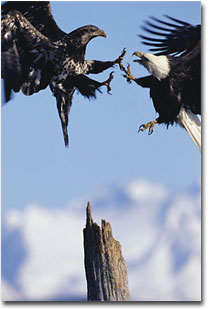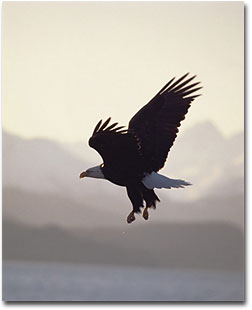 The story of the bald eagle says a lot about our ability to destroy nature. It also says something about our ability to restore it, if we care enough. Itís a story with special significance these days, as so many revere the American eagle as never before. Thanks to the efforts of many researchers, wardens, bird enthusiasts and others who have helped to bring the bald eagle back from the brink of destruction, we still enjoy these magnificent birds in much of the United States today.
The story of the bald eagle says a lot about our ability to destroy nature. It also says something about our ability to restore it, if we care enough. Itís a story with special significance these days, as so many revere the American eagle as never before. Thanks to the efforts of many researchers, wardens, bird enthusiasts and others who have helped to bring the bald eagle back from the brink of destruction, we still enjoy these magnificent birds in much of the United States today.
On June 20, 1782 the Second Continental Congress selected the bald eagle as the national symbol. Not long after that, we declared war against these magnificent birds. We killed them for ceremonial feathers, wasted them for sport, shot them as rivals for species that we wanted for ourselves and destroyed their nesting habitat. Finally, we introduced a poison into their food supply in massive quantities. With the widespread use of the insecticide DDT after the late 1940ís, we nearly eliminated the bald eagle from the planet. DDT washed into lakes, ponds, rivers and streams. It built up in the fish that eagles fed on. It accumulated in the body of eagles and caused a variety of harmful effects. DDT laced fragile and porous eggshells proved especially disastrous for the bald eagle.
From an estimated population in the early 1700ís of 100,000 birds in what we today call the lower 48 United States, humans collectively whittled down the bald eagle to the mere 417 nesting pairs found by researchers in all of those states in the early 1960ís.
Rachel Carson sounded the call to arms over the problems caused by DDT in her seminal book Silent Spring, and its use was banned in the United States in 1972. Then, in recognition that the species was vanishing, in 1978 we protected the bald eagle - which is found only in North America - as an endangered species in most the of lower 48 states. Congress required the United States Fish & Wildlife Service (USF&WS) to develop a plan to bring the bald eagle back from the brink of extinction.
The recovery has been successful enough that in July 1995, the bald eagle was down-listed to a threatened status throughout the lower 48 states. The bald eagle population in the lower 48 states today has a population estimated at nearly 6,000 breeding pairs.
Those who wish to photograph the bald eagle still need to do so with utmost care and respect. The law aside, too close an approach to an active nest site can cause the loss of eggs or chicks, as the parents scramble in distress or stay off of the nest too long on a cold day. Also, be careful not to spook eagles during winter. The expenditure of any energy can be critical to survival during these cold weather months.
A few tips for better eagle photographs without interfering include:

- Use a long telephoto lens, at least 400mm. Most of the eagle images in my files required 500mm or more, except for some rare opportunities such as on a cliffside in Alaska where you could fill the frame wing tip to wingtip with 300mm.
- Use a sturdy tripod or an IS lens. The rule of thumb for handholding a lens - use a shutter speed as fast as the fraction made by the number 1 over the length of the lens in millimeters - really does apply unless, youíre shooting with an Image Stabilizer lens from Canon lens or the lone Vibration Reduction 80-400 zoom lens in Nikonís arsenal.
- A top quality teleconverter matched properly to a lens can extend the range of a lens with publishable results. Read that to say that a low priced, low quality teleconverter is a waste of money. In camera equipment, you usually do get what you pay for. Nowhere is that more true than with teleconverters.
- Never approach too closely on foot. Even bald eagles that are used to seeing people at special locations get nervous when humans approach on foot.
- Use a structure, a boat or a vehicle as a blind. If youíre moving in on a bird, donít try to get too close or get there too fast. Watch the birdís body language for clues. Itís far better to arrive at a place where you expect to see eagles before they do and wait. As in most camera hunting, patience is the key
- Window mounts or beanbags provide stable support when in a vehicle. My preference is to set up a Gitzo tripod in the vehicle, by tipping one leg 90 degrees from the other two and running it out to fit tightly against the passenger side door. Set the other two legs for a convenient height between the seat and the driverís door (assuming youíre on that side) and you get a very stable platform, better than any window mount. Just be sure to shut the engine off to stop vibrations.
Bald eagles still thrive in Canada and Alaska, which enjoy at least an estimated 50,000 birds each. But these birds need our help as much as the gradually recovering population found in the lower 48 United States if the bald eagle is to survive the steady onslaught of development of its natural habitat. We must protect historic nesting sites, food sources and roosting areas of these birds if future generations of nature photographers are to enjoy the same opportunities that we do today.
In my home state of Maine, weíve been doing that by cooperative agreements with landowners and in many cases, outright purchase of special sites from willing landowners by groups such as The Nature Conservancy and the Maine Coast Heritage Trust, folks who protect land the old fashioned way Ė they buy it. Photographs that show the beauty of these birds help them to get donations of the funds required for this important work. Perhaps you can help in your own region?
On a personal note...
I will never forget the last time that I ran into Galen. I was the photography instructor for Great Canadian Ecoventures in the Northwest Territories for two weeks in 1999, and Galen was coming in to do the same thing for the last week of the season.
Tundra Tom's plane, a float equipped Beaver, was down, probably due to a lightning strike at the camp a couple days before that had fried the generator. We were waiting for a Cessna to bring in a mechanic and new parts. Barbara and Galen came in on that Cessna on a scuzzy day that required flying under a low ceiling at the end of the three day blow that had kept us hunkered down.
While Barbara warmed up by the cookshack stove, Galen and I visited about how the caribou were. That year they were coming right down into camp, and he was surprised when I told him that, with patience, we could get full frame images of some of the big bulls with a wide angle lens. He seemed excited at the prospects that lay ahead for his week in that wondrous environment, 230 miles into the bush.
Part of why I will never forget that day is because I left Tundra Tom's Whitefish Lake Camp late that afternoon on that same Cessna as the pilot scud flew back to Yellow Knife to get out before the ceiling dropped any lower. It was a long trip.
I learned a lot about shooting scenes from several careful readings of his book Mountain Light about 15 years ago that has helped my career greatly. I'd recommend it to anyone.
We all go to the wilds with some risk. Be sure to enjoy the moment. And if you can capture it the way Galen Rowell always strove to, consider yourself among the lucky.
Catch yours in the good light.
BS-NPN 012
http://camerahunter.com
Comments on Bill Silliker, Jr.'s The Camera Hunter articles? Send them to the editor.
Maine wildlife & nature photographer Bill Silliker, Jr. Ė The Mooseman - photographed at many wild places in North America, with the results published in magazines internationally and in 9 of his own books. Bill was an instructor of wildlife and nature photography for L. L. Bean's Outdoor Discovery Program and a member of the Fuji Film Talent Team. Read more about Bill on the Camera Hunter archives page.



